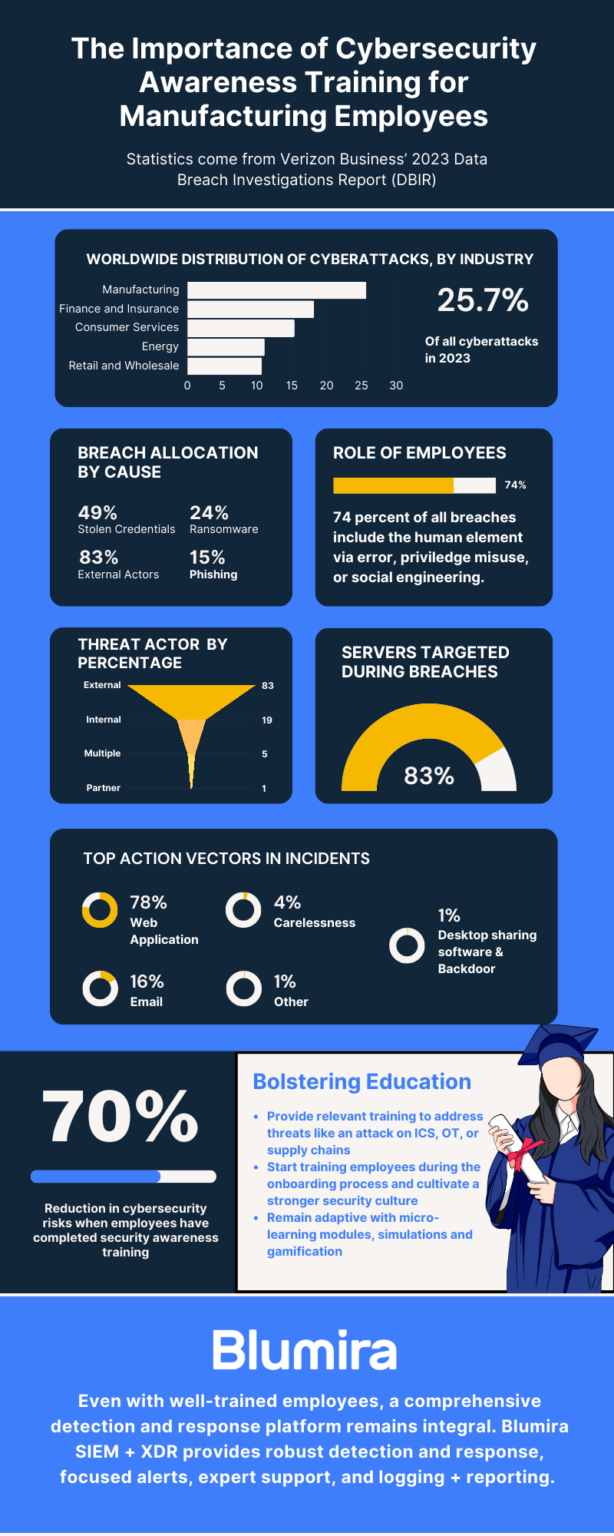Cybersecurity Awareness and Education for Manufacturing Employees
Manufacturing facilities are full of warning signs: Look out for forklifts. Watch your step. Bend your knees. Wear a hardhat. Do not enter. Restricted access. Beware. Danger. Caution. Bright, bold signs are strategically placed as visible reminders to employees to keep physical safety and security top of mind. The same needs to be done for cybersecurity threats.
In order to reduce incidents that could cause injuries and costly downtime, employees are trained from the start to be aware of potential hazards, protect themselves and others, and report issues. A similar outline can be a model to help employees understand their role in cybersecurity – awareness , education, and reporting.

Humans hold the key to cyber protection
Just as employees play a crucial role in protecting safety and reducing hazards, they also have the potential to make a difference when it comes to thwarting cybersecurity attacks. Analysis of cybersecurity incidents shows that about three quarters of them involve a human element like an error, privilege misuse, stolen credentials, or social engineering. Simply said, cyber attackers are finding ways to access organizations by exploiting a lack of attention or understanding. And they’re especially attracted to manufacturing firms, which saw the highest share of cyberattacks among industries worldwide in 2023 – nearly a quarter of reported incidents.
Even when you’ve got a threat detection and response platform like Blumira, cybersecurity protection starts with prevention. That’s where employees come in. Fostering a culture in which employees are proactive about protecting assets and data goes a long way toward denying access to bad actors.
Empower your employees to recognize and respond to potential threats with these tips for an engaging cybersecurity awareness and education program:
Awareness
- Communicate clear policies – Ensure all employees are aware of cybersecurity policies and procedures. Write them in clear language and make sure every employee signs off.
- Have a plan – Your awareness plan should include frequent reminders of policies, procedures, and expectations. Many manufacturing firms work with their marketing team to identify the most effective channels for messaging employees.
- Integrate physical security – Employees should understand the connection between physical and cybersecurity. Facility signage can be a reminder to be vigilant at points of vulnerability.
- Communicate the spectrum of potential threats – It can be tempting to focus on the most unique cybersecurity threats, or communicate only about incidents that have recently been detected. Employees should understand their responsibilities for everything from passwords and workstation access to phishing and social engineering.
- Explain the consequences – Help employees understand what can happen when someone gains unauthorized access – how ransomware can bring work to a halt, and a data breach can impact the firm’s finances and reputation.
Education
- Provide training that’s relevant – Customize your training content so it addresses specific threats and scenarios encountered in manufacturing, such as risks associated with industrial control systems (ICS), operational technology (OT), and supply chains. Use real-world examples and case studies to illustrate potential threats.
- Onboarding and beyond – Cybersecurity awareness and training needs to start on day one if you’re going to build a strong security culture. New employees should take away an understanding of how important cybersecurity is to your organization. Follow up with a continuous flow of information that reinforces your message.
- Always be learning – Cybersecurity threats are constantly evolving, so training should be ongoing. Regular updates and refreshers can be presented in team meetings, lunch-and-learns, and engaging activities. Some ways to keep cybersecurity interesting include:
- Micro-learning modules – By breaking training into smaller, manageable modules, you reduce the burden of long training sessions while improving retention.
- Hands-on simulations – Another way to engage employees is with hands-on exercises. This can include phishing simulations, breach response drills, and incident handling exercises.
- Gamification – Interactive techniques such as quizzes, competitions, and reward systems can make training fun and memorable.
Reporting
- Normalize vigilance – Some employees may not want to speak up if they’re unsure what a cyberthreat looks like. Or, they may feel shame if they made a security mistake. Cybercriminals rely on people feeling those feelings. Make sure everyone is empowered to report their concerns.
- Make reporting easy – Establish and communicate a clear mechanism for reporting suspicious emails, activity, or behaviors – even if employees aren’t quite sure what they’re seeing.
- Conduct incident drills – Regular incident response drills can help employees practice and reinforce the procedures and ensure readiness.
Awareness, education, and reporting will help manufacturing employees be at the front line of cybersecurity prevention. Your program should also include regular feedback so employees can see that their efforts are making an impact. Blumira SIEM will track incidents, response time, and trends, and you can use Blumira reports to identify areas that need additional emphasis or improvement.
Robust detection and response
Even with well-trained, vigilant employees, a robust cybersecurity detection and response platform is a necessity. Blumira SIEM + XDR offers a number of benefits for manufacturing companies, including:
Easy to set up and use – Get up and running quickly without having to hire expensive consultants. Your team will find it easy to navigate Blumira, understand alerts, and follow response playbooks.
Advanced detection and response – Blumira provides comprehensive coverage, includes multiple integrations, and has unique features like honeypots. Blumira automation blocks threats so you can handle them before they move through your environment.
Focused alerts – Blumira consolidates and prioritizes notifications to help you focus on the most important detections. Avoid burnout and alert fatigue when your team isn’t chasing noise.
Expert support – Blumira experts, including solution architects, security operations, incident detection, and technical support, become an extension of your team.
Logging and reporting – The Blumira SIEM + XDR platform stores unlimited amounts of data for at least one year, with the option for longer term storage. It also includes standard as well as custom reports.
Try Blumira XDR free for 30 days or use our Free SIEM with three cloud integrations and 14 days of data retention forever. Sign up to start protecting your organization in minutes.
More from the blog
View All Posts
Customer Story: Mid-Sized Manufacturing Firm
Read MoreHow Manufacturers Can Secure Themselves Against Cyber Threats
Read More
Four Cornerstones Of Cyber Resilience In Modern Manufacturing
Read MoreSubscribe to email updates
Stay up-to-date on what's happening at this blog and get additional content about the benefits of subscribing.